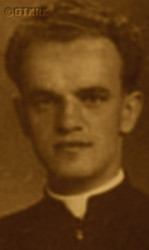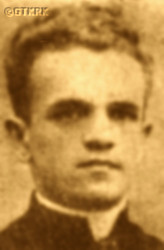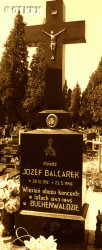Roman Catholic
St Sigismund parish
05-507 Słomczyn
85 Wiślana Str.
Konstancin deanery
Warsaw archdiocese, Poland
full list:
displayClick to display full list

searchClick to search full list by categories
wyświetlKliknij by wyświetlić pełną listę po polsku

szukajKliknij by przeszukać listę wg kategorii po polsku

Martyrology of the clergy — Poland
XX century (1914 – 1989)
personal data
religious status
Servant of God
surname
BALCAREK
forename(s)
Joseph Louis (pl. Józef Alojzy)
function
diocesan priest
creed
Latin (Roman Catholic) Church RCmore on
en.wikipedia.org
[access: 2014.09.21]
diocese / province
Katowice diocesemore on
en.wikipedia.org
[access: 2013.05.19]
RC Military Ordinariate of Polandmore on
en.wikipedia.org
[access: 2014.12.20]
date and place
of death
23.05.1946

Ustrońtoday: Ustroń urban gm., Cieszyn pov., Silesia voiv., Poland
more on
en.wikipedia.org
[access: 2021.12.18]
details of death
After German and Russian invasion of Poland in 09.1939 and start of the World War II member of Polish clandestine resistance organizations Armed Struggle Union ZWZ and Home Army AK (part of Polish Clandestine State).
Arranged help for repressed Polish families.
Despite a ban delivered sermons in Polish.
Provided shelter and support to ZWZ and AK couriers.
Hid and provided shelter to wanted by the Germans members of ZWZ and AK.
Arrested by the Germans on 11.11.1943.
Jailed in Cieszyn and Mysłowice prisons.
Next transferred to KL Buchenwald concentration camp.
Liberated in 1945.
Totally exhausted returned to his diocese.
Did not recover though and soon perished.
cause of death
exhaustion and disease
perpetrators
Germans
sites and events
KL BuchenwaldClick to display the description, EG MyslowitzClick to display the description, CieszynClick to display the description, Regierungsbezirk KattowitzClick to display the description, Ribbentrop‐MolotovClick to display the description, Pius XI's encyclicalsClick to display the description
date and place
of birth
30.12.1912Birth certification on:
digi.archives.cz
[access: 2025.09.07]

KarvináTrans‐Olza
today: Karviná dist., Moravian‐Silesian reg., Czechia
more on
en.wikipedia.org
[access: 2022.01.28]
parents
BALCAREK Paul
🞲 ?, ? — 🕆 ?, ?

KRYSTA Anne
🞲 ?, ? — 🕆 ?, ?
baptism
06.01.1913Birth certification on:
digi.archives.cz
[access: 2025.09.07]

KarvináTrans‐Olza
today: Karviná dist., Moravian‐Silesian reg., Czechia
more on
en.wikipedia.org
[access: 2022.01.28]
St Henry RC church
presbyter (holy orders)
ordination
25.12.1939

Katowicetoday: Katowice city pov., Silesia voiv., Poland
more on
en.wikipedia.org
[access: 2021.08.12]
St Peter and St Paul the Apostles RC cathedral churchmore on
pl.wikipedia.org
[access: 2016.04.23]
positions held
1945 – 1946
vicar — Szarlejtoday: district of Piekary Śląskie, Piekary Śląskie city pov., Silesia voiv., Poland
more on
en.wikipedia.org
[access: 2021.04.02] ⋄ Holy Trinity RC parish ⋄ Piekary Śląskietoday: Piekary Śląskie city pov., Silesia voiv., Poland
more on
en.wikipedia.org
[access: 2021.04.02] RC deanery
1945
vicar — Skoczówtoday: Skoczów gm., Cieszyn pov., Silesia voiv., Poland
more on
en.wikipedia.org
[access: 2020.10.13] ⋄ St Peter and St Paul the Apostles RC parish ⋄ Skoczówtoday: Skoczów gm., Cieszyn pov., Silesia voiv., Poland
more on
en.wikipedia.org
[access: 2020.10.13] RC deanery
1940 – 1943
vicar — Górki Wielkietoday: Brenna gm., Cieszyn pov., Silesia voiv., Poland
more on
en.wikipedia.org
[access: 2022.01.28] ⋄ All the Saints RC parish ⋄ Skoczówtoday: Skoczów gm., Cieszyn pov., Silesia voiv., Poland
more on
en.wikipedia.org
[access: 2020.10.13] RC deanery — substitute
vicar — Pruchnatoday: Strumień gm., Cieszyn pov., Silesia voiv., Poland
more on
en.wikipedia.org
[access: 2021.12.18] ⋄ St Anne RC parish ⋄ Strumieńtoday: Strumień gm., Cieszyn pov., Silesia voiv., Poland
more on
en.wikipedia.org
[access: 2021.12.18] RC deanery
vicar — JablunkovTrans‐Olza
today: Frýdek‐Místek dist., Moravian‐Silesian reg., Czechia
more on
en.wikipedia.org
[access: 2022.01.28] ⋄ Corpus Christi RC parish ⋄ JablunkovTrans‐Olza
today: Frýdek‐Místek dist., Moravian‐Silesian reg., Czechia
more on
en.wikipedia.org
[access: 2022.01.28] RC deanery
vicar — Ustrońtoday: Ustroń urban gm., Cieszyn pov., Silesia voiv., Poland
more on
en.wikipedia.org
[access: 2021.12.18] ⋄ St Clement, the Pope and Martyr RC parish ⋄ Cieszyntoday: Cieszyn gm., Cieszyn pov., Silesia voiv., Poland
more on
en.wikipedia.org
[access: 2021.12.18] RC deanery
till 1939
student — Krakówtoday: Kraków city pov., Lesser Poland voiv., Poland
more on
en.wikipedia.org
[access: 2021.06.07] ⋄ Department of Theology, Jagiellonian University UJ
1937 – 1939
student — Krakówtoday: Kraków city pov., Lesser Poland voiv., Poland
more on
en.wikipedia.org
[access: 2021.06.07] ⋄ philosophy and theology, Theological Seminary ⋄ Kraków RC archdiocese
1933 – 1937
student — Kielcetoday: Kielce city pov., Holy Cross voiv., Poland
more on
en.wikipedia.org
[access: 2021.06.07] ⋄ philosophy and theology, Theological Seminary
sites and events
descriptions
KL Buchenwald: In German Germ. Konzentrationslager (Eng. concentration camp) KL Buchenwald concentration camp, founded in 1937 and operational till 1945, Germans held c. 238,380 prisoners and murdered approx. 56,000 of them, among them thousands of Poles. Prisoners were victims of pseudo‐scientific experiments, conducted among others by Behring‐Werke from Marburg and Robert Koch Institute from Berlin companies. They slaved for Gustloff in Weimar and Fritz‐Sauckel companies manufacturing armaments. To support Erla‐Maschinenwerk GmbH in Leipzig, Junkers in Schönebeck (airplanes) and Rautal in Wernigerode Germans organized special sub‐camps. In 1945 there were more than 100 such sub‐camps. Dora concentration camp was initially one of them, as well as KL Ravensbrück sub‐camps (from 08.1944). On 08.04.1945 Polish prisoner, Mr Guido Damazyn, used clandestinely constructed short wave transmitter to sent, together with a Russian prisoner, a short message begging for help. It was received and he got a reply: „KZ Bu. Hold out. Rushing to your aid. Staff of Third Army” (American). Three days later the camp was liberated. (more on: www.buchenwald.deClick to attempt to display webpage
[access: 2013.08.10], en.wikipedia.orgClick to attempt to display webpage
[access: 2013.08.10])
EG Myslowitz: Germ. Polizei Ersatz Gefängnis in Myslowitz (Eng. Police Substitute Prison Mysłowice) was operational from 13.02.1941 till 22.01.1945. Altogether c. 18,000 people went through it, including c. 2,000 women, mainly citizens of the Katowice regency, part of Germ. Provinz Oberschlesien (Eng. Upper Silesia Province) — on average from 100 to 1,200 at any one time. Initially only men were held captive. From 1941 also women were admitted, and from the beginning of 1943 a part of camp was dedicated to underage boys (underage girls were held in women block). Tortures were used. Killings and executions took place. Germans used also the camp to select people for public executions, without a proper court proceedings. Most of the prisoners, including children and teens were subsequently dispatched to concentration and death camps (mainly to nearby KL Auschwitz). (more on: ipn.gov.plClick to attempt to display webpage
[access: 2020.05.25])
Cieszyn: Remand jail run by German political police Gestapo — in the southern part (today: Czech) of town — and investigative prison — in northern (Polish) side, on the other bank of Olza river — run by Germans. In 1940 the prisoners were initially held in Cieszyn jail but next, due to an overcrowding, taken to former Josef and Jacob Kohn furniture manufacturing plant, by Frydecka Str. and Jabłonkowa Str. junction on the southern bank of Olza, where a transit camp was set up. The prisoners — more than 1,000 Poles went through the camp — were interrogated and whipped with horsewhips, prior to being sent to German concentration camps. (more on: www.sw.gov.plClick to attempt to display webpage
[access: 2013.08.10])
Regierungsbezirk Kattowitz: After the Polish defeat in the 09.1939 campaign, which was the result of the Ribbentrop‐Molotov Pact and constituted the first stage of World War II, and the beginning of German occupation in part of Poland (in the other, eastern part of Poland, the Russian occupation began), the Germans divided the occupied Polish territory into five main regions (and a few smaller). The largest one was transformed into Germ. Generalgouvernement (Eng. General Governorate), intended exclusively for Poles and Jews and constituting part of the so‐called Germ. Großdeutschland (Eng. Greater Germany). From two separate new provinces were created. The two remaining were incorporated into existing German provinces. One of those was Polish Upper Silesia, which on 08.09.1939, by decree of the German leader Adolf Hitler (formally came into force on 26.10.1939), was incorporated into Germany as the Germ. Regierungsbezirk Kattowitz (Eng. Katowice Regency) and became part of the Germ. Provinz Schlesien (Eng. Province of Silesia) based in Wrocław. On 01.04.1940, the Germ. Regierungsbezirk Kattowitz was enlarged by several pre‐war German counties, and on 18.01.1941, a new German province was created, the Germ. Provinz Oberschlesien (Eng. Province of Upper Silesia), which, apart from the Germ. Regierungsbezirk Kattowitz, also included the Opole region. From 26.10.1939, when the regency was established, the law of the German state was in force there, the same as in Berlin. The main axis of the policy of the new regency, the territory of which the Germans recognized as the Germ. „Ursprünglich Deutsche” (Eng. „natively German”), despite the fact only 6% of its pre–war Polish part were Germans, was Germ. „Entpolonisierung” (Eng. „Depolonisation”), i.e. forced Germanization. The main mechanism was the introduction of the Germ. Deutsche Volksliste DVL, a German nationality list that was supposed to specify the national affiliation of the inhabitants of the region. The largest group marked in the compulsory registrations was Group 3, people who identified themselves as „Silesians” (in 1943 about 41%), and people remaining outside the DVL (about 36%). The latter group was intended to be deported to the Germ. Generalgouvernement (which did not happen en masse because German industry needed slave labor). Group 3, considered by the Germans as capable of Germanization, was subject to certain legal restrictions, and was subject to, among others, to conscription into the German Wehrmacht army. Children could only learn in German. A policy of terror was pursued against the Polish population. There was a special police court, controlled by the Germ. Geheime Staatspolizei (Eng. Secret State Police), i.e. the Gestapo, before which c. 4,000‐5,000 people were detained. For the years 1942‐1945 over 2,000 of them were verified, of which 1,890 were sentenced to death, including 286 in public executions. Thousands of people were murdered during the so‐called «Intelligenzaktion Schlesien», including 300‐650 Polish teachers and c. 61 Polish Catholic priests. The regency hosted a German concentration and extermination camp KL Auschwitz, where the Germans imprisoned c. 1,100,000 Jews (murdering c.1,000,000, i.e. c. 90% of them) and c. 140,000 Poles (murdering c. 70,000, i.e. c. 50% of them). After the end of hostilities of World War II, the overseer of this province, the Germ. Reichsstatthalter (Eng. Reich Governor) and the Germ. Gauleiter (Eng. district head) of the German National Socialist Party, Fritz Brecht, committed suicide. (more on: en.wikipedia.orgClick to attempt to display webpage
[access: 2024.06.24])
Ribbentrop‐Molotov: Genocidal Russian‐German alliance pact between Russian leader Joseph Stalin and German leader Adolf Hitler signed on 23.08.1939 in Moscow by respective foreign ministers, Mr. Vyacheslav Molotov for Russia and Joachim von Ribbentrop for Germany. The pact sanctioned and was the direct cause of joint Russian and German invasion of Poland and the outbreak of the World War II in 09.1939. In a political sense, the pact was an attempt to restore the status quo ante before 1914, with one exception, namely the „commercial” exchange of the so‐called „Kingdom of Poland”, which in 1914 was part of the Russian Empire, fore Eastern Galicia (today's western Ukraine), in 1914 belonging to the Austro‐Hungarian Empire. Galicia, including Lviv, was to be taken over by the Russians, the „Kingdom of Poland” — under the name of the General Governorate — Germany. The resultant „war was one of the greatest calamities and dramas of humanity in history, for two atheistic and anti‐Christian ideologies — national and international socialism — rejected God and His fifth Decalogue commandment: Thou shall not kill!” (Abp Stanislav Gądecki, 01.09.2019). The decisions taken — backed up by the betrayal of the formal allies of Poland, France and Germany, which on 12.09.1939, at a joint conference in Abbeville, decided not to provide aid to attacked Poland and not to take military action against Germany (a clear breach of treaty obligations with Poland) — were on 28.09.1939 slightly altered and made more precise when a treaty on „German‐Russian boundaries and friendship” was agreed by the same murderous signatories. One of its findings was establishment of spheres of influence in Central and Eastern Europe and in consequence IV partition of Poland. In one of its secret annexes agreed, that: „the Signatories will not tolerate on its respective territories any Polish propaganda that affects the territory of the other Side. On their respective territories they will suppress all such propaganda and inform each other of the measures taken to accomplish it”. The agreements resulted in a series of meeting between two genocidal organization representing both sides — German Gestapo and Russian NKVD when coordination of efforts to exterminate Polish intelligentsia and Polish leading classes (in Germany called «Intelligenzaktion», in Russia took the form of Katyń massacres) where discussed. Resulted in deaths of hundreds of thousands of Polish intelligentsia, including thousands of priests presented here, and tens of millions of ordinary people,. The results of this Russian‐German pact lasted till 1989 and are still in evidence even today. (more on: en.wikipedia.orgClick to attempt to display webpage
[access: 2015.09.30])
Pius XI's encyclicals: Facing the creation of two totalitarian systems in Europe, which seemed to compete with each other, though there were more similarities than contradictions between them, Pope Pius XI issued in 03.1937 (within 5 days) two encyclicals. In the „Mit brennender Sorge” (Eng. „With Burning Concern”) published on 14.03.1938, condemned the national socialism prevailing in Germany. The Pope wrote: „Whoever, following the old Germanic‐pre‐Christian beliefs, puts various impersonal fate in the place of a personal God, denies the wisdom of God and Providence […], whoever exalts earthly values: race or nation, or state, or state system, representatives of state power or other fundamental values of human society, […] and makes them the highest standard of all values, including religious ones, and idolizes them, this one […] is far from true faith in God and from a worldview corresponding to such faith”. On 19.03.1937, published „Divini Redemptoris” (Eng. „Divine Redeemer”), in which criticized Russian communism, dialectical materialism and the class struggle theory. The Pope wrote: „Communism deprives man of freedom, and therefore the spiritual basis of all life norms. It deprives the human person of all his dignity and any moral support with which he could resist the onslaught of blind passions […] This is the new gospel that Bolshevik and godless communism preaches as a message of salvation and redemption of humanity”… Pius XI demanded that the established human law be subjected to the natural law of God , recommended the implementation of the ideal of a Christian state and society, and called on Catholics to resist. Two years later, National Socialist Germany and Communist Russia came together and started World War II. (more on: www.vatican.vaClick to attempt to display webpage
[access: 2023.05.28], www.vatican.vaClick to attempt to display webpage
[access: 2023.05.28])
sources
personal:
www.encyklo.plClick to attempt to display webpage
[access: 2021.12.19], newsaints.faithweb.comClick to attempt to display webpage
[access: 2014.01.06], digi.archives.czClick to attempt to display webpage
[access: 2025.09.07]
original images:
www.encyklo.plClick to attempt to display webpage
[access: 2021.12.19], www.bsip.miastorybnik.plClick to attempt to display webpage
[access: 2017.11.07], forum.gazeta.plClick to attempt to display webpage
[access: 2014.03.21]
LETTER to CUSTODIAN/ADMINISTRATOR
If you have an Email client on your communicator/computer — such as Mozilla Thunderbird, Windows Mail or Microsoft Outlook, described at WikipediaPatrz:
en.wikipedia.org, among others — try the link below, please:
LETTER to CUSTODIAN/ADMINISTRATORClick and try to call your own Email client
If however you do not run such a client or the above link is not active please send an email to the Custodian/Administrator using your account — in your customary email/correspondence engine — at the following address:

giving the following as the subject:
MARTYROLOGY: BALCAREK Joseph Louis
To return to the biography press below:
 Click to return to biography
Click to return to biography










